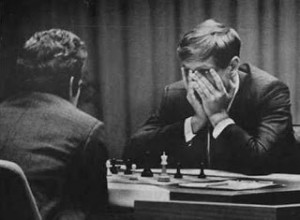Growing up in Corvallis, Oregon, math prodigy and future weapons designer Rod Hyde seemed to have two things on his mind: chess and science fiction. Gordon Dickson, Keith Laumer and Robert Heinlein had fed his adolescence with images of man’s future in space, and by the time he was interviewed by the New York Times‘ William Broad for a book called Star Warriors (1985), he was talking about getting humans off the planet as a means of species survival. Rod was at Lawrence Livermore National Laboratory then, deep in the world of nuclear weapons design and the ideas that would emerge as ‘Star Wars.’
Not the movie, of course, but the Reagan-era defensive shield that would, it was hoped, bring down incoming missiles and forever alter the balance of power. As anti-Soviet as they come, Hyde always took the long-range view when the conversation moved to the future. He tells Broad:
“What I want more than anything is essentially to get the human race into space. It’s the future. If you stay down here some disaster is going to strike and you’re going to be wiped. If you get into space and spread out there’s just no chance of the human race disappearing.”

I was thinking about all this today because last night I gave a talk on interstellar mission concepts and discussed species survival as a driver for building up the space-based infrastructure that might eventually make them possible. But I also thought about the young Rod Hyde because I was once, totally without my knowing it, in the same venue with him in Reykjavik, Iceland. Back in 1972, Bobby Fischer went to Reykjavik to take on Russia’s Boris Spassky in a world championship chess match. I was in Reykjavik because I was studying Old Norse, the language of the Vikings, and the direct ancestor of modern Icelandic. Hyde was there for the chess.
Image: Bobby Fischer (right) shoots Boris Spassky a glance as the latter mulls his position in 1972’s world chess championship. Credit: Morgunblaðið.
Now Reykjavik is a small place, back then about 80,000, and when I wasn’t in the museums or the incredibly numerous bookstores, I went to as many of the chess matches as I could, where Fischer put on his usual antics, like showing up after the clock had already started and swooping in with affected nonchalance to make his opening move. A chess championship at that level is a bit surreal. No one dared to make a sound, and if even a rustle of whispering broke out in the audience, the Icelandic word þögn! (silence) would instantly appear on the screen above the players. Because long thought went into each move, watching the match mostly involved being perfectly still and waiting for something to happen.
The crowd loved it. Icelanders love chess anyway, doubtless the result of long indoor hours during the dark winter, which also explains the ubiquitous bookshops. They would sit in silence for long minutes until one of the players made a move. Then nods would break out, or perhaps a sigh. Sometimes the move was dramatic, and then a collective gasp would go up as Spassky or Fischer seemed to get the edge. I would see people glancing at each other in puzzlement or approval and resolved to learn how to play chess better, a promise I never really kept.
I bet Hyde had the time of his life. The Reykjavik championship had come just at the time when his designs for a starship had reached completion. Back in 1972, Rod had finished up at MIT and, when not playing in chess tournaments of his own, had begun to look for graduate fellowships. The search led to an offer of a summer job working on laser fusion rockets with Livermore’s Lowell Wood. The 19-year old thus went to work at the weapons lab and, working with the ideas of Wood and John Nuckolls, developed a design for a starship engine that would put out power like no engine ever had. He had fusion in mind, and his thoughts had been influenced by laser developments.

Image: The ISV Venture Star, from James Cameron’s film Avatar. Note the radiators, about which more tomorrow. Credit: Lightstorm Entertainment/20th Century Fox.
Broad tells the story: Rod was transfixed by the starship idea but, as a huge fan of Fischer’s, determined to be in Reykjavik for the chess championship. He began working long days and into the night pounding on the design, at one point locking himself in his office for four straight days to produce a final paper that would later be presented at a conference in New Orleans. Broad says that Lowell Wood led the sleep-deprived Hyde out to his car to take him to the airport for the Iceland flight, and we can only hope that he somehow got a bit of sleep on the plane. I doubt it, though, because in those days going to Iceland involved an aged DC-8 with cramped seats, a noisy cabin, and usually a full passenger manifest. I lost a lot of sleep on those crossings.
But Hyde was a genuine workaholic. I’ve already mentioned his youth when he received his undergraduate degree, and once he began at Livermore, he split time between the lab and MIT as he went on to receive an M.S. in 1973 and, now working full-time at Livermore, a doctorate in 1976. He was contemptuous of Soviet rocket design and deeply distrustful of Soviet intentions, but underlying all the personal geopolitics was the idea of space as a solution to human problems. Broad quotes him in the course of a long interview on the political situation of the time:
“I want the future to be up in space because there is just so much more out there… Here you can’t play games with new political systems because every piece of land is already owned by someone. It’s a zero-sum game. Out there, it’s absolutely limitless. There’re no more frontiers here. Space is one big frontier.”
Thus Rod’s membership in the Citizens Advisory Council on National Space Policy, which science fiction writer Jerry Pournelle had founded, and which was sponsored by both the American Astronautical Society and the L-5 Society. And thus his obsession with going to the stars, which obviously grew out of a childhood steeped in science fiction coupled with a mathematical and engineering bent that led him to seek new solutions. Tomorrow I want to talk a bit more about Hyde and the starship ideas that would emerge from this restless polymath.



“He [Rod Hyde] was contemptuous of Soviet rocket design…”
Some of the people in the link below had personal experience of how bizarre the Soviet system could be. But you don’t have to agree with the system they lived under to recognize their contributions (see other pages on the site as well):
http://www.mentallandscape.com/V_Biographies.htm
Rod’s work at LLNL on developing very large scale Fresnel optics for space telescopes may also prove to be a major contribution to interstellar space explorations. Eventually 100m optics will allow essential data to be collected about target planets prior to launching any vehicle.
Ref.: Development of large-aperture, light-weight Fresnel lenses for Gossamer space telescopes. Dixit, Sham | Hyde, Rod | Weisberg, Andrew | Early, Jim | Rushford, Mike | Britten, Jerry 43rd AIAA/ASME/ASCE/AHS/ASC Structures, Structural Dynamics, and Materials Conference, Denver, CO; UNITED STATES; 22-25 Apr. 2002. 2002
If you read William Broad’s “Star Warriors,” make sure you read his follow-up book “Teller’s War” (1992) for a balanced perspective.
Agreed, Andrew, though I wasn’t reading Star Warriors for Broad’s dated take on the ‘Star Wars’ matter but specifically for the background on Hyde and his starship ideas. There are better, more recent sources on Star Wars itself.
I wonder what your conclusions were as regards “species survival as a driver for building up the space-based infrastructure that might eventually make them [interstellar missions] possible”?
Do you really foresee species survival as motivating the kind of governments that run today’s world? Or might more traditional profit-making and economic growth (with a smidgen of species survival thrown in to tart up the visionary speeches of wealthy entrepreneurs) prove a more reliable build-up mechanism?
Stephen
Oxford, UK
Stephen, yes, I do see species survival as a motivator especially for public opinion and pressure to act wisely, but I don’t see this happening any time soon. My belief is that long-term thinking is itself a long-term project, and we (and the governments we deal with) are a long way from making use of it. My own intention is to keep hammering at it in hopes of being one voice advocating this approach. No argument with the idea that profit-making and economic growth would be potent if they can be enlisted in support.
Well, you’ve got a private sector that thinks of the next three months and politicians that (at most) think of the next six years, in part because running for office requires so much money that politicians are always running for office. It’ll take drastic reform of our entire economic/political system to change that.